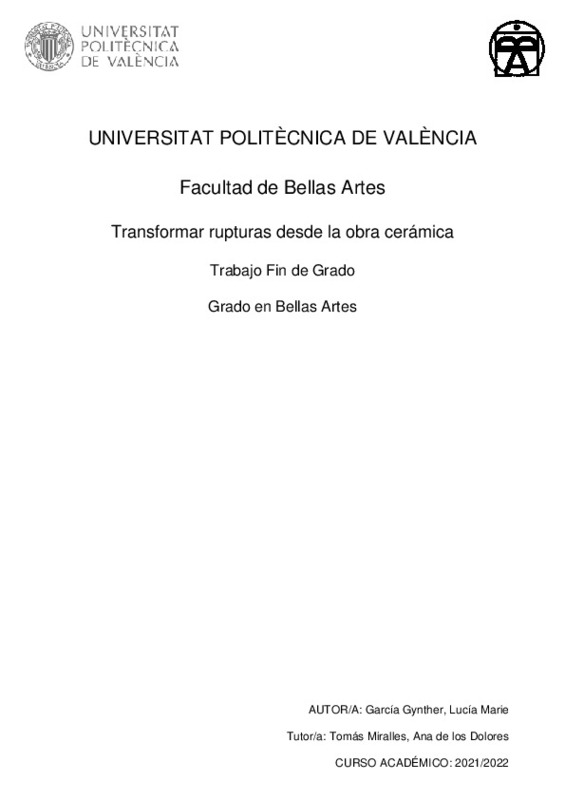JavaScript is disabled for your browser. Some features of this site may not work without it.
Buscar en RiuNet
Listar
Mi cuenta
Estadísticas
Ayuda RiuNet
Admin. UPV
Transformar rupturas desde la obra cerámica
Mostrar el registro sencillo del ítem
Ficheros en el ítem
| dc.contributor.advisor | Tomás Miralles, Ana de los Dolores
|
es_ES |
| dc.contributor.author | García Gynther, Lucía Marie
|
es_ES |
| dc.date.accessioned | 2022-07-13T08:33:59Z | |
| dc.date.available | 2022-07-13T08:33:59Z | |
| dc.date.created | 2022-07-12 | |
| dc.date.issued | 2022-07-13 | es_ES |
| dc.identifier.uri | http://hdl.handle.net/10251/184071 | |
| dc.description.abstract | [ES] El proyecto consiste en una serie de piezas cerámicas que están rotas o a las que les faltan pedazos. En lugar de categorizar dichas piezas como no válidas o inservibles por sus rotos, la idea es transformarlas rellenando la superficie del hueco donde falta el pedazo o pedazos con retales hechos mediante la técnica del ganchillo. La idea subyacente en esta serie es la de ¿reparar¿ y transformar rupturas y vacíos. Las piezas cambian así para siempre y tal vez nunca vuelvan a su estado original, pero sí se puede transformar ese ¿desperfecto¿ en algo que puede llegar a ser más bello e interesante. Este proceder es similar al de la técnica japonesa del Kintsugi, que trataré con más detalle en los siguientes capítulos, y con la que, en lugar de intentar disimular o tapar las grietas de la cerámica rota, dichas grietas se destacan utilizando polvo de oro o de plata. La decisión de tapar los huecos con ganchillo, se debe a la diferencia tan grande entre los materiales. Una vez cocida, la cerámica es dura, rígida, fría, y brillante si lleva esmalte. La lana es suave, blanda, y se puede amoldar. Al juntar estos dos materiales, de características tan diferentes y al mismo tiempo de similares orígenes rústicos y artesanales, se crea un juego visual de texturas agradable, donde ambos se han descontextualizado con el fin de buscar una nueva utilidad juntos. | es_ES |
| dc.description.abstract | [EN] The project consists of a series of ceramic vessels which are broken or have missing pieces. Instead of categorizing these vessels as invalid or useless due to their flaws, the idea is to transform them by filling in the surface of the gaps where chunks are missing with patches made using the crochet technique. The idea behind this series is to mend and transform ruptures and gaping voids. Thus, the vessels change forever and may never return to their original state, but that flaw can be transformed into something even more beautiful and interesting. This procedure is similar to the Japanese Kintsugi technique, which I will discuss in the following chapters. Instead of trying to hide or cover the cracks in the broken vessel, in Kintsugi pieces said cracks are highlighted using gold or silver dust. The reason for choosing to cover the holes with crochet is because of the stark contrast between the materials. After it is fired, clay becomes hard, rigid, cold, and shiny if a glaze is applied. Wool is soft, smooth, and malleable. By putting together these two materials, with such different characteristics and, at the same time of similar rustic, artisanal origins, a pleasant visual interplay of textures is created, where both materials have been de-contextualized in order to find a new utility together. | es_ES |
| dc.format.extent | 42 | es_ES |
| dc.language | Español | es_ES |
| dc.publisher | Universitat Politècnica de València | es_ES |
| dc.rights | Reconocimiento - No comercial - Compartir igual (by-nc-sa) | es_ES |
| dc.subject | Cerámica | es_ES |
| dc.subject | Ruptura | es_ES |
| dc.subject | Vacío | es_ES |
| dc.subject | Reconstrucción | es_ES |
| dc.subject | Reciclar | es_ES |
| dc.subject | Desperfecto. | es_ES |
| dc.subject | Ceramic | es_ES |
| dc.subject | Rupture | es_ES |
| dc.subject | Void | es_ES |
| dc.subject | Reconstruction | es_ES |
| dc.subject | Recycle | es_ES |
| dc.subject | Flaw. | es_ES |
| dc.subject.classification | DIBUJO | es_ES |
| dc.subject.other | Grado en Bellas Artes-Grau en Belles Arts | es_ES |
| dc.title | Transformar rupturas desde la obra cerámica | es_ES |
| dc.title.alternative | Transform ruptures | es_ES |
| dc.title.alternative | Transformar ruptures | es_ES |
| dc.type | Proyecto/Trabajo fin de carrera/grado | es_ES |
| dc.rights.accessRights | Abierto | es_ES |
| dc.contributor.affiliation | Universitat Politècnica de València. Departamento de Dibujo - Departament de Dibuix | es_ES |
| dc.contributor.affiliation | Universitat Politècnica de València. Facultad de Bellas Artes - Facultat de Belles Arts | es_ES |
| dc.description.bibliographicCitation | García Gynther, LM. (2022). Transformar rupturas desde la obra cerámica. Universitat Politècnica de València. http://hdl.handle.net/10251/184071 | es_ES |
| dc.description.accrualMethod | TFGM | es_ES |
| dc.relation.pasarela | TFGM\147752 | es_ES |
Este ítem aparece en la(s) siguiente(s) colección(ones)
-
BBAA - Trabajos académicos [4517]
Facultad de Bellas Artes






